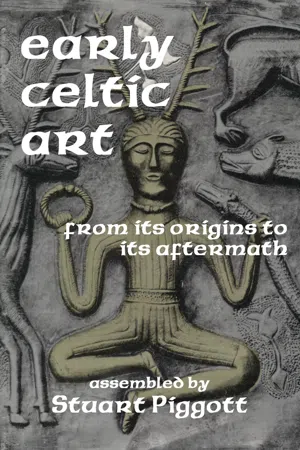
- 77 pages
- English
- ePUB (mobile friendly)
- Available on iOS & Android
About this book
For many, perhaps most, the title Early Celtic Art summons up images of Early Christian stone crosses in Ireland, Scotland, Wales, or Cornwall; of Glendalough, lona or Tintagel; of the Ardagh Chalice or the Monymusk Reliquary; of the great illuminated gospels of Durrow or Lindisfame. But as Stuart Piggott notes, the consummate works of art produced under the aegis of the early churches in Britain or Ireland, in regions Celtic by tradition or language, have an ancestry behind them only partly Celtic.
One strain in an eclectic style was borrowed from the ornament of the northern Germanic world, the classical Mediterranean, and even the Eastern churches. Early Celtic art, originating in the fifth century b.c. in Central Europe, was already seven or eight centuries old when it was last traced in the pagan, prehistoric world, and the transmission of some of its modes and motifs over a further span of centuries into the Christian Middle Ages was an even later phenomenon. This volume presents the art of the prehistoric Celtic peoples, the first great contribution of the barbarians to European arts.
It is an art produced in circumstances that the classical world and contemporary societiesunhesitatingly recognize as uncivilized. Its appearance, it has been said by N. K. Sandars in Prehistoric Art in Europe: "is perhaps one of the oddest and most unlikely things to have come out of a barbarian continent. Its peculiar refinement, delicacy, and equilibrium are not altogether what one would expect of men who, though courageous and not without honor even in the records of their enemies, were also savage, cruel and often disgusting; for the archaeological refuse, as well as the reports of Classical antiquity, agree in this verdict."
This book comprises the first major exhibition of Early Celtic Art from its origins and beginnings to its aftermath, and was assembled by Stuart Piggott who taught later European prehistory to Honors students in Archaeolog
Frequently asked questions
- Essential is ideal for learners and professionals who enjoy exploring a wide range of subjects. Access the Essential Library with 800,000+ trusted titles and best-sellers across business, personal growth, and the humanities. Includes unlimited reading time and Standard Read Aloud voice.
- Complete: Perfect for advanced learners and researchers needing full, unrestricted access. Unlock 1.4M+ books across hundreds of subjects, including academic and specialized titles. The Complete Plan also includes advanced features like Premium Read Aloud and Research Assistant.
Please note we cannot support devices running on iOS 13 and Android 7 or earlier. Learn more about using the app.
Information
6
Adornment and Display
112 Gold armlet (replica)
113 Gold tore * (replica)
114 Gold tore * (replica)
115 Gold tore* (replica)
116 Gold tore * (replica)
117 Gold armlet * (replica)
118 Pair of gold armlets (replicas)
119 Gold tore (replica)
120 Pair of gold bracelets (replicas)
121 Gold armlet (replica)
122 Gold armlet
123 Bronze tore
Table of contents
- Cover Page
- Title Page
- Copyright Page
- Table of Contents
- Foreword
- Introduction
- References and Abbreviations
- Author’s Acknowledgments
- Origins and Beginings
- The Warriors
- Horses and Chariots
- Religion ano Mogie
- The Hearth and the Feast
- Adornment and Display
- Aftermath
- The Coins
- List of Lenders